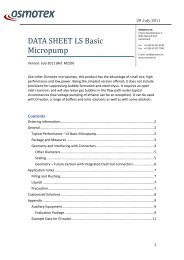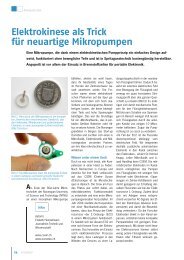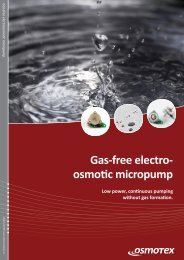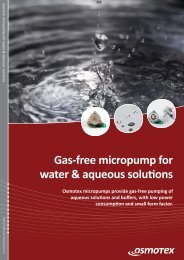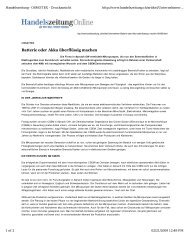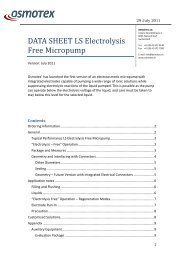“Electrolysis – Free” Operation - Osmotex
“Electrolysis – Free” Operation - Osmotex
“Electrolysis – Free” Operation - Osmotex
You also want an ePaper? Increase the reach of your titles
YUMPU automatically turns print PDFs into web optimized ePapers that Google loves.
DATA SHEET FC Pump<br />
Version: July 2011 a (Ref: M170-M173)<br />
29 July 2011<br />
OSMOTEX AG<br />
Untere Gründlistrasse 1<br />
6055 Alpnach Dorf<br />
Switzerland<br />
Tel. +41 (0) 41 672 9140<br />
Fax +41 (0) 41 672 7500<br />
E.mail: info@osmotex.ch<br />
www.osmotex.ch<br />
The FC Pump was developed for low power pumping of alcohols such as ethanol and<br />
methanol. Intended uses are indirect pumping using alcohols as driving liquid, and<br />
fuel cells.<br />
Contents<br />
Ordering Information ..................................................................................................... 2<br />
General ........................................................................................................................... 2<br />
<strong>“Electrolysis</strong> <strong>–</strong> <strong>Free”</strong> <strong>Operation</strong> .................................................................................. 2<br />
Package and Measures .............................................................................................. 3<br />
Geometry and Interfacing with Connectors .............................................................. 3<br />
Other Diameters .................................................................................................... 4<br />
Sealing .................................................................................................................... 4<br />
Geometry <strong>–</strong> Future Version with Integrated Electrical Connectors ...................... 5<br />
Customized Solutions ..................................................................................................... 6<br />
Application notes ........................................................................................................... 6<br />
Filling and Flushing ..................................................................................................... 6<br />
Liquids ........................................................................................................................ 7<br />
Precaution .................................................................................................................. 7<br />
Gas-free operation <strong>–</strong> Regeneration Modes ............................................................... 7<br />
Appendix ........................................................................................................................ 9<br />
Auxiliary Equipment ................................................................................................... 9<br />
Evaluation Package ................................................................................................ 9<br />
Electronic Control Unit ......................................................................................... 12<br />
Flow Sensor Feedback Control System ................................................................ 12<br />
Valve Flow Rectifier ............................................................................................. 12<br />
Example Data ........................................................................................................... 13<br />
High-Accuracy Flow-Feedback System .................................................................... 15<br />
1
Ordering Information<br />
For orders, please contact:<br />
<strong>Osmotex</strong> AG<br />
Untere Gründlistrasse 1<br />
6055 Aplnach Dorf<br />
Switzerland<br />
Tel: +41 41 672 9140 / 41<br />
Fax: +41 41 672 75 00<br />
Info@<strong>Osmotex</strong>.ch<br />
General<br />
<strong>Osmotex</strong>’ electroosmotic (EO) pumps have the following advantages:<br />
29 July 2011<br />
• Very compact disc-shaped design, typical dimensions Ø15mm, thickness 2-<br />
4mm<br />
• Do not create gas bubbles in flow path given a certain counter pressure<br />
(some versions)<br />
• Reduced influence of electrochemistry<br />
• Low power<br />
• Silent<br />
• Low cost, suitable for volume applications<br />
<strong>Osmotex</strong> develops advanced EO pumps with strongly reduced influence of<br />
electrochemistry and bubble formation, when used in the correct way.<br />
Electrochemical reactions should still be considered when considering new liquids.<br />
While <strong>Osmotex</strong>’ standard products cover a wide range of power, flow rates, liquids<br />
and other conditions, <strong>Osmotex</strong> can also develop customized solutions when needed.<br />
Standard pumps are delivered un-calibrated. Like for other EO pumps, the flow <strong>–</strong><br />
pressure <strong>–</strong> voltage characteristics depends on the liquid used. <strong>Osmotex</strong> also offers<br />
robust solutions with flow-sensor feedback control.<br />
<strong>“Electrolysis</strong> <strong>–</strong> <strong>Free”</strong> <strong>Operation</strong><br />
<strong>Osmotex</strong>’ FC Pump include reversible electrodes to suppress un-desired<br />
electrochemical processes. As a result, the voltage (and hence the liquid flow) must<br />
be reversed at intervals of up to ca 6 hours. Although electrochemical reactions are<br />
never totally absent, this results in a smooth and bubble-free flow between the<br />
reversals. A flow rectifying valve system is offered to create a uni-directional flow<br />
(see below).<br />
2
Package and Measures<br />
Shape: Circular disc<br />
Diameter: 14 mm<br />
Thickness: 1.8 mm<br />
29 July 2011<br />
Despite different characteristics, all <strong>Osmotex</strong> micropumps are embedded in the<br />
same type compact plastic package (diameter 2cm, thickness 2mm to 4mm). These<br />
“Pump Cores” (figure 1) do not include fluidic and electric connectors.<br />
<strong>Osmotex</strong> also offers an evaluation package with fluidic and electric connectors<br />
(figure 1).<br />
Figure 1: <strong>Osmotex</strong> micropump “Core”. The liquid flow generated is perpendicular<br />
to the clover-shaped area in the disc center.<br />
Geometry and Interfacing with Connectors<br />
In the following is included information necessary to design fluidic and electrical<br />
connectors. The clover shaped area in the centre must be available for liquid flow,<br />
while the area around can be used for sealing. For example, a flat rubber gasket with<br />
diameter large enough to encircle the clover can be pressed against the Pump Core.<br />
3
Figure 2: Top/bottom view.<br />
Figure 3: Side view.<br />
29 July 2011<br />
Other Diameters<br />
The standard version has electrode diameter 6mm (open flow diameter 5 mm as<br />
shown on figure). <strong>Osmotex</strong> also offer versions with diameters 4 and 8 mm, with<br />
maximum flow rates approximately half and double that of the standard version,<br />
respectively.<br />
Sealing<br />
The micropump can be interfaced with fluidic connectors using a gasket, for example<br />
made of a rubber such as NBR, FKM or (for less deformation) EPDM. It is important<br />
that the rubber does not block the gas venting holes and that the gass is allowed to<br />
pass to the atmosphere.<br />
4
29 July 2011<br />
Geometry <strong>–</strong> Future Version with Integrated Electrical<br />
Connectors<br />
<strong>Osmotex</strong> plans to launch a version of the micropump with electric connectors on the<br />
top face of the disc shaped Pump Core. This will provide a more compact design<br />
without leads sticking out from the periphery. The exact measures of the product<br />
might differ from the provisional measures presented in this section.<br />
Figure 4: Top view, integrated connectors (provisional measures).<br />
Figure 5: Side view, integrated connectors (provisional measures).<br />
5
Figure 6: Bottom view, integrated connectors (provisional measures).<br />
29 July 2011<br />
Customized Solutions<br />
<strong>Osmotex</strong> can engage in application specific development for producers of end user<br />
equipment. Our broad expertise in electrokinetics and microfluidics makes us ready<br />
to meet most challenges, whether the need is a simple pump with package, a robust<br />
design with flow rate feedback control, or the integration of several<br />
pumps on a chip.<br />
Application notes<br />
Filling and Flushing<br />
The pump can be primed by using a syringe while taking care not to inject air to the<br />
pump or applying excessive pressure.<br />
To obtain stable flow, there should be a constant water level in the inlet reservoir.<br />
NB Electroosmotic pumps cannot suck air and are not self priming.<br />
6
29 July 2011<br />
Liquids<br />
The pump has been tested for Methanol and Ethanol. Other polar organic liquids<br />
might show a similar performance, depending on their properties. For aqueous<br />
solutions it works similarly to the LS Electrolysis Free micropump (see corresponding<br />
data sheet).<br />
Precaution<br />
The pump should not be run at higher voltages than 20V (15V for aqueous or higher<br />
conductivity solutions) and should never be allowed to run dry, as this could lead to<br />
breakdown of the electrodes and porous pump structure.<br />
Gas-free operation <strong>–</strong> Regeneration Modes<br />
<strong>Osmotex</strong> FC Pump has palladium electrodes to avoid catalytic bubble formation.<br />
Hydrogen will under many circumstances act as the main positive current carrier,<br />
and the storage capability of palladium eliminates the formation of<br />
hydrogen bubbles at the cathode. The pump should always be operated with (very)<br />
low frequency AC voltage in order to avoid emptying or overfilling either hydrogen<br />
storing electrode. Further, the current should never be so high as to result<br />
in surface filling (over saturating the electrode surface with hydrogen, leading to<br />
damage). A dual polarity square pulse signal with variable duty-cycle can be used. In<br />
order to stay within these safe conditions, the current should be electronically<br />
monitored and voltage amplitude and direction adjusted as necessary (e.g. change<br />
direction of voltage before one electrode is over filled or emptied). A less<br />
sophisticated control system might be used (e.g. applying pulses of equal amplitude<br />
and duration but opposite sign), however the pump lifetime and performance will be<br />
reduced.<br />
Max charge storage capacity of each electrode: ca 8 Coulomb (2.2 mAh).<br />
Critical current for surface filling of hydrogen storing electrode: ca 40 mA<br />
Recommended max current: 10 mA.<br />
During the initial half-cycle, hydrogen will be generated and stored in the negative<br />
electrode (cathode). It is recommended to pre-fill with up to 80% of the total<br />
hydrogen storage capacity, and then move an amount of charge corresponding to<br />
60% of the total charge in subsequent half-cycles of a low frequency square pulse<br />
signal. This leaves a margin of 20% from over-filling an electrode.<br />
7
For example:<br />
29 July 2011<br />
1. Apply 10 V until a total charge of 1.76 mAh has been transferred<br />
2. Apply 10 V with opposite polarity until a charge of 1.32 mAh has been transferred<br />
3. In subsequent use, reverse the polarity (and hence flow direction) every time a<br />
charge of 1.32 mAh has been transferred in one direction<br />
Flow direction: towards positive electrode.<br />
<strong>Osmotex</strong> electronic control unit OPC-20 handles the flow reversals automatically,<br />
and can simultaneously control a valve system assuring uni-directional flow in<br />
synchronization (se below).<br />
8
Appendix<br />
Auxiliary Equipment<br />
<strong>Osmotex</strong> can deliver the FC Pump embedded in an open reservoir evaluation<br />
package with standard fluidic and electrical connectors.<br />
Evaluation Package<br />
29 July 2011<br />
Figure 7: Closed evaluation package with fluidic and electric connectors (right) and<br />
its parts including the “Pump Core” (left). The fluidic connector has inner diameter<br />
1.7 mm and outer 2.5 mm.<br />
9
29 July 2011<br />
Figure 8: <strong>Osmotex</strong>’ closed connector would fit into a cylinder as shown (top and<br />
side views).<br />
Figure 9: Evaluation package with fluidic and electric connectors and open inlet<br />
reservoir. The fluidic connector has inner diameter 1.7 mm and outer 2.5 mm.<br />
10
29 July 2011<br />
Figure 10: <strong>Osmotex</strong>’ open reservoir connector would fit into a cylinder as shown<br />
(top and side views).<br />
Figure 11: Electrical contact at connectors.<br />
11
Electronic Control Unit<br />
<strong>Osmotex</strong> OPC-20 electronic controller can be used for the following purposes:<br />
29 July 2011<br />
- Programmable power supply for micropump operation (USB interface to PC)<br />
- Controlling the reversal rate for bubble-free operation<br />
- Automatic control of the valve rectifier system<br />
- Flow feedback control (with flow sensor) for high precision flow<br />
Flow Sensor Feedback Control System<br />
<strong>Osmotex</strong> offers a solution with flow sensor for high accuracy pumping, see data<br />
section.<br />
Valve Flow Rectifier<br />
As the bubble-free micropump needs flow reversals at certain intervals, <strong>Osmotex</strong><br />
developed a flow rectifier giving a uni-directional flow to the application. On figure<br />
12, the right-pointing arrows indicate the directed flow, while the smaller double<br />
arrows show the pumping back- and forth. It might be further adapted to an indirect<br />
pumping system which is not dependent on limited reservoirs. Although the use of<br />
small passive valves was demonstrated to work well for several hours, passive valves<br />
are only considered to be reliable enough with future high pressure versions of the<br />
pump core. At the moment, standard electromechanical valves are used. Being bistable,<br />
the valves are only actuated at the moment of switching, resulting in low<br />
power consumption (at the level of the pump’s) and less mechanical wear. The<br />
valves are controlled in synchronization with the pump by <strong>Osmotex</strong> electronic<br />
control unit<br />
Figure 12: Flow-rectifying valve system.<br />
12
Example Data<br />
29 July 2011<br />
Figure 13: Left: Flow in µl/min vs pressure at 5, 10 and 15 V. Right: Flow vs voltage<br />
at 0, 1, 2, 3 PSI (0, 69, 138, 276 mBar).<br />
13
Figure 14: Comparison of flow rates for 3 micropumps (methanol).<br />
29 July 2011<br />
Figure 15: Comparison of power consumption for 3 different pumps (methanol)<br />
14
High-Accuracy Flow-Feedback System<br />
<strong>Osmotex</strong>’ feedback system is based on Sensirion Flow sensors.<br />
Figure 16: Flow sensor and high precision flow with feedback loop.<br />
29 July 2011<br />
15



